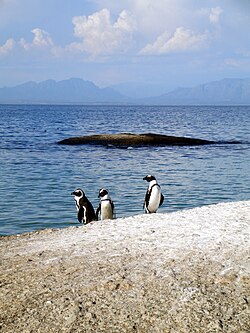Penguin Islands
rocks awash | |
| Major islands | Possession Island, Penguin Island and Seal Island |
|---|---|
| Administration | |
Namibia | |


The Penguin Islands (
Geography
The islands are scattered over a long coastal region. Although a few of them form small clusters or groups, such as the islands in Lüderitz Bay, the Penguin Islands lack the mutual proximity of a natural archipelago or island chain.
The largest island is Possession Island with 0.90 km2 (0.35 sq mi) in area. Hollam's Bird Island is the most northern and, at a distance of 10.3 kilometres (6.4 mi), the farthest from the coast. All islands together measure 2.35 km2 (0.91 sq mi) in area.[1]
Islands
Listed from the most northern to the most southern, the islands include the Penguin Islands (in the historic, narrower sense - printed in bold):
- Hollam's Bird Island (24°38′21″S 14°31′52″E / 24.63917°S 14.53111°E)
- Mercury Island (25°43′10″S 14°49′59″E / 25.71944°S 14.83306°E)
- Ichaboe Island (26°17′20″S 14°56′12″E / 26.28889°S 14.93667°E)
- Black Rock (26°5′0″S 14°58′0″E / 26.08333°S 14.96667°E)
- Staple Rock (26°22′0″S 14°58′0″E / 26.36667°S 14.96667°E)
- Marshall Reef (26°22′0″S 14°58′0″E / 26.36667°S 14.96667°E)
- Boat Bay Rocks (26°25′0″S 15°5′0″E / 26.41667°S 15.08333°E)
- Seal Island , Lüderitz Bay (26°35′45″S 15°9′22″E / 26.59583°S 15.15611°E)
- Penguin Island, Lüderitz Bay (26°37′0″S 15°9′15″E / 26.61667°S 15.15417°E)
- Halifax Island (26°39′3″S 15°4′47″E / 26.65083°S 15.07972°E)
- North Long Island (26°49′14″S 15°7′32″E / 26.82056°S 15.12556°E)
- South Long Island (26°49′57″S 15°7′41″E / 26.83250°S 15.12806°E)
- Possession Island (27°0′49″S 15°11′40″E / 27.01361°S 15.19444°E)
- Albatross Island (27°7′9″S 15°14′18″E / 27.11917°S 15.23833°E)
- Pomona Island (27°11′37″S 15°15′29″E / 27.19361°S 15.25806°E)
- Black Rock (24°56′0″S 14°48′0″E / 24.93333°S 14.80000°E)
- Black Sophie Rock (27°38′0″S 15°31′0″E / 27.63333°S 15.51667°E)
- Plumpudding Island (27°38′31″S 15°30′49″E / 27.64194°S 15.51361°E)
- Sinclair Island (Roast Beef Island) (27°39′56″S 15°31′13″E / 27.66556°S 15.52028°E)
- Little Roastbeef Islets (27°42′0″S 15°32′0″E / 27.70000°S 15.53333°E)
History
Uninhabited, strategically located, rich in
The annexation was originally intended to form part of an overall absorption of South West Africa into the Cape Colony forming one locally governed British colony. This was to be instituted by the Palgrave Commission (1876).
British interference and the resulting breakdown in relations between the British Empire and the local Cape government obstructed the Commission's work long enough for Germany to declare South West Africa a German protectorate in 1884 as part of the continent-wide Scramble for Africa. The offshore islands (and Walvis Bay) were excluded from German administration by their status as Cape constituencies.[4] This status was recognised by Germany in 1886. Thus, although close to the mainland, the islands were not part of German South West Africa.[5]
In 1990, South West Africa gained independence as Namibia. The Penguin Islands remained under South African sovereignty, thus letting it retain an
References
- ^ "Namibian Islands' Marine Protected Area : WWF South Africa Report Series – 2008/Marine/003" (PDF). Nacoma.org.na. Archived from the original (PDF) on 3 March 2016. Retrieved 22 November 2015.
- ^ "The online guide to Namibia: Guano". NamibWeb.com. Retrieved 2015-11-22.
- ^ Academie de Droit International de La Hague. Recueil Des Cours, 1986: Collected Courses of the Hague Academy of International Law. The Hague: Martinus Nijhoff Publishers, 1988. p.213.
- ^ John Dugard: Namibia-South Africa Treaty on Walvis Bay. American Society of International Law. International Legal Materials, Vol. 33, No. 6 (NOVEMBER 1994), pp. 1526-1528.
- ^ Hertslet, Sir Edward (1894). The map of Africa by treaty. Vol. 1. pp. 345–46.
- ^ Klaus Dierks. "Namibia's Walvis Bay Issue - Origin and Rise of a Colonial Dispute". Klausdierks.com. Retrieved 2015-11-22.
